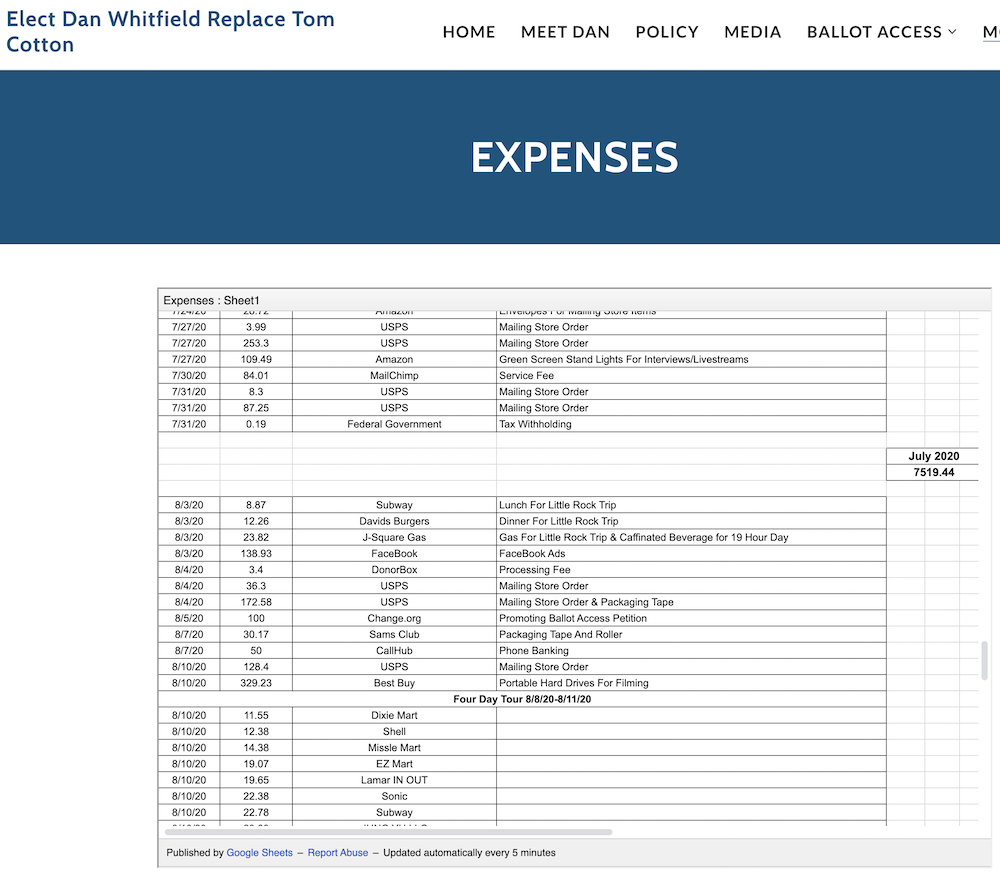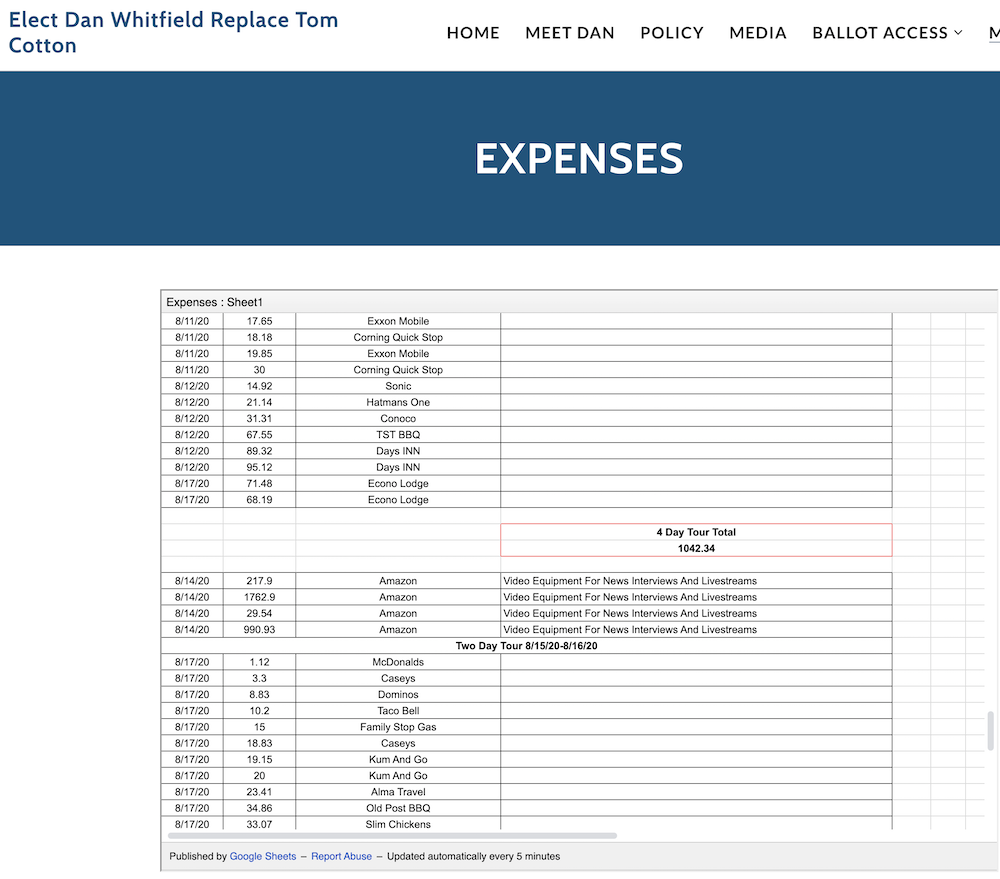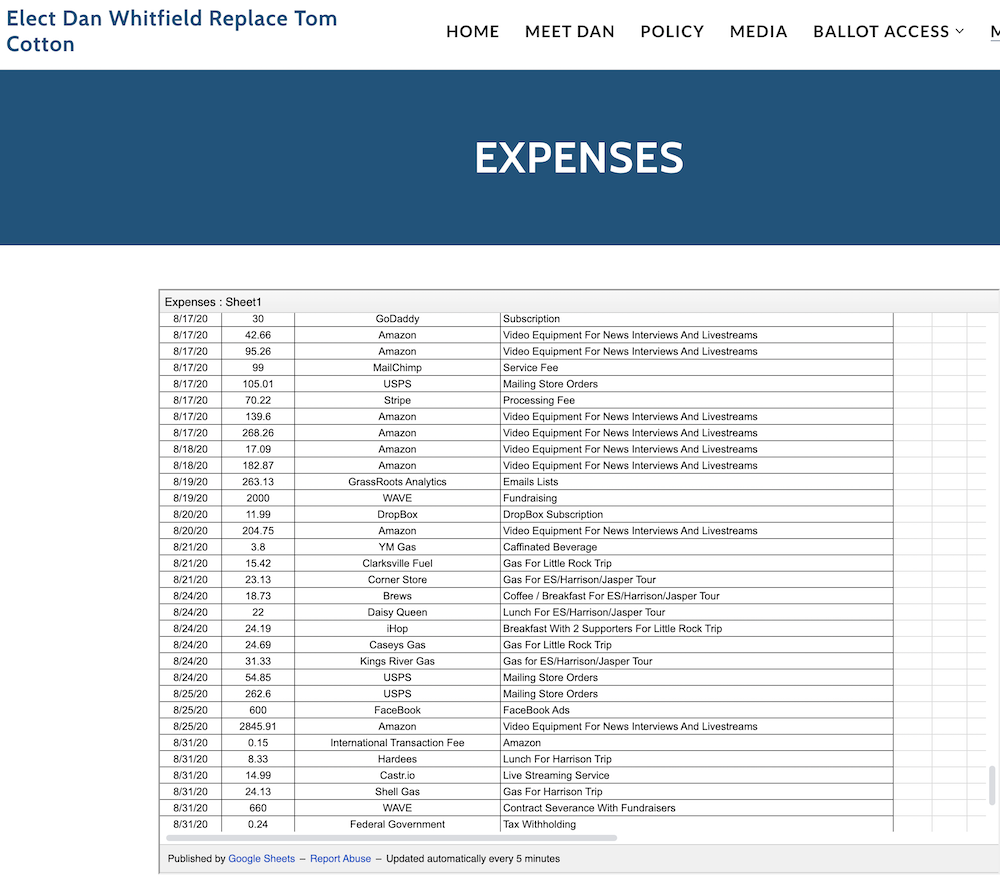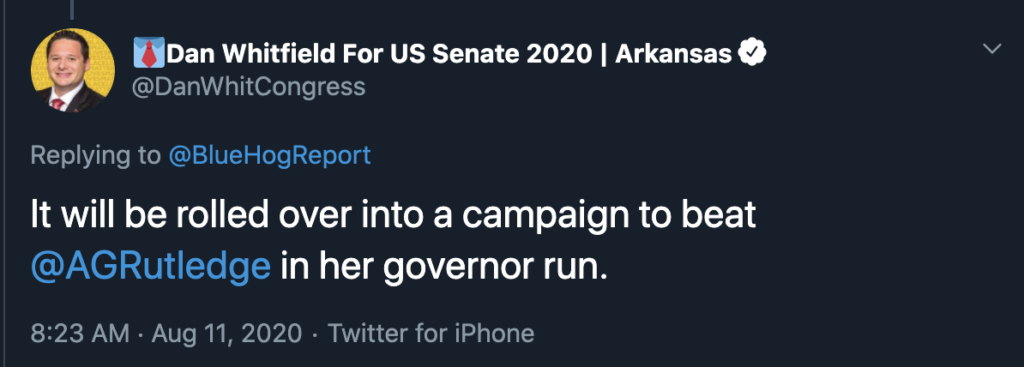I promised myself that I would not do another post about cosplay US Senate candidate Dan Whitfield.1 I really meant it, too. Yet…I am apparently unable to ignore bizarre uses of campaign funds, no matter how I try, so here we are.
If you have ever peeked at Whitfield’s campaign website, you might have noticed that he has a Google document that itemizes the spending from his campaign account.2 Correction: An earlier version of this post said that his quarterly report was due 9/15; it is due 10/15. So, I moseyed over to Whitfield’s website to peruse said Google document to look at his recent expenditures.
Scrolling to the most recent transactions, I noticed a payment of $2,845.91 to Amazon for “Video Equipment For News Interviews And Livestreams.”

“That’s odd,” I said after thinking that it was definitely odd. After all, why in the world would a guy who is not on the ballot and will not be on the ballot spend nearly $3,000 on video equipment in late August? Before I could come up with an answer to that, however, I noticed two things. First, that 8/25 purchase was after Whitfield had learned that, despite his constant claims to the contrary, he would not have oral arguments in his appeal in September, which seems like an awful strange time to be spending that much money on equipment for his Hindenburg of a campaign.
Second, and much more strangely, I realized that the 8/25 purchase was one of a string of purchases of video equipment that Whitfield made in August.



That is $329.23 for “Portable Hard Drives For Filming” and $5,197.67 for “Video Equipment For News Interviews And Livestreams,” for a total of $5,526.90 in video-equipment purchases in the month of August alone. Throw in another $61.79 in “Video Equipment For News Interviews And Livestreams” that he has purchased so far in September and you get a grand total of $5,588.69 since August 1.
Prior to August, Whitfield had spent a grand total of $406.04 on equipment that could charitably be considered related to filming “news interviews” or livestreams.3 Despite that comparatively paltry spending on equipment, Whitfield was able to pump out a near-constant stream of self-aggrandizing videos and livestreams. Why would a campaign that was going nowhere need to upgrade its video equipment at this late date when a lack of that new equipment had not been an issue to that point?
Not that the video equipment is the only strange spending since August 1, mind you. On August 31, he paid $660 to something called WAVE for “Contract Severance With Fundraisers.” Yet, just twelve days earlier, on August 19, he had paid WAVE $2000 for fundraising. Similarly, and also on August 19, Whitfield paid GrassRoots Analytics $263.13 for “Emails Lists;” fifteen days later, on September 3, he paid $364.06 to GrassRoots for “Contract Severance.”
Severing those contracts so soon after they were entered looks to me like a campaign that sees the writing on the wall and knows that there is no point in continuing to pay for the types of things that contribute to actually campaigning. That would certainly fit timeline-wise, as both contracts were entered/paid for on August 19, two days before Whitfield learned that his appeal would not have oral arguments in September, and anyone with even a lick of sense4 would have known that oral arguments during the week of October 19-23 would be far too late for Whitfield to possibly get on the ballot for the November 3 election.
Except, if that is the case, then we are right back where we started, questioning the video-equipment purchases. So what gives? Why the sudden uptick in spending on equipment at the same time as his chances for ballot access circle the proverbial drain faster and faster? We cannot say for certain, but I think, based on what we know about Dan Whitfield, that we can hazard a guess or two.
For instance, we can say with some certainty that Dan Whitfield has a ridiculously unfounded belief as to what office(s) he should hold and how he will get there. We saw it when he half-heartedly tried to run against Steve Womack in 2018, ignoring advice from people who told him that he would not be able to get the necessary signatures in the timeframe that he had available. We have seen it during this ill-fated run against Tom Cotton (R-Koch Industries), as Whitfield has attacked Cotton’s actual opponent, Ricky Harrington Jr. (L-Pine Bluff), nearly as much as he has attacked Cotton in recent weeks. And we have absolutely seen it in tweets like this one from Whitfield whenever he has been pressed on what he plans to do with campaign funds if he does not make it on the ballot:

In short, Dan Whitfield has repeatedly demonstrated that he is more interested in being “famous” and running for offices that jibe with his misplaced sense of self importance than in running for an office that he might actually have a chance of winning. He has also shown, through comments about his plans to use Senate-race money for a state-level race in 2022, that he does not have a particularly good grasp on what is actually legal as far as using campaign funds.
Put all those facts together, and it seems like a safe bet that the reason Dan Whitfield spent nearly $5,600 on video equipment in the last month and a half is because he knows his chances of being on the 2020 ballot are dead, but he plans to inundate Arkansas voters with a steady stream of videos and livestreams over the next two years as he decides what pipedream elected office to shoot for next, concocts new conspiracy theories about how the system is working against him, and just generally tries to keep his name, face, and ugly tie knots in the public consciousness long enough to continue the ego-trip and the grift associated with it.
But here’s the thing: assets, such as “Video Equipment For News Interviews And Livestreams,” that a candidate buys for his Senate campaign with Senate-campaign funds remain assets of the campaign, not the individual, even after the campaign ends. They can be disposed of in accordance with rules for disposing of campaign funds, they could be sold (with the proceeds from the sale going into the campaign account), or they could be transferred to a future federal campaign just like how excess campaign funds could be transferred. What the candidate cannot do is take all that equipment for personal use or use that equipment for a state-level race in Arkansas without the state-level campaign first purchasing the equipment from the Senate campaign.
I am sure that Whitfield will claim that of course he is not just going to take the video equipment for personal use and of course he plans to pay the Senate campaign for it or otherwise act in accordance with state and federal law. Consider, however: (1) this guy has a track record of not knowing what the law is in the first place; (2) he has apparently (finally) realized that his Senate-race ballot access is DOA, but he has not admitted as much to his supporters or would-be donors and continues to receive contributions to that moribund campaign; and (3) he has spent over a third of the total amount spent on his Senate campaign in the last 45 days, even as the odds of his being on the ballot went from absurdly small to basically non-existent.
In other words, at best, the video equipment is going to be part of the ad nauseum videos and livestreams Whitfield uses to keep the grift going for the next two-plus years. And, based on his track record, we should not even give Whitfield the benefit of that best-case assumption until we see a paper trail or other proof of how the equipment was handled or disposed of post-campaign.
(I-Not on your ballot)↩
It is no stretch to say that this is the best thing about his campaign, and something I wish more candidates would do. So, um, kudos to Whitfield for that.↩
$109.49 for a green-screen set up, $121.48 for three wireless microphones, and $175.07 for a PA system.↩
Granted, I’m assuming that Dan Whitfield fits this category, despite actual evidence to the contrary.↩